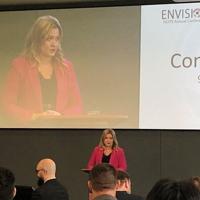Terrorists and extremists are evolving, finding new and ingenious ways to attack our nation and its infrastructure.
Academics — including some here in Omaha — are evolving their own new ways to keep up and stop them.
That was one theme of “Envision 22,” the annual conference of the National Counterterrorism Innovation, Technology and Education Center this week in Omaha.
About 150 experts and students from 13 states plus Washington, D.C., and Great Britain are attending the two-day event, which will wrap up Friday at the University of Nebraska at Omaha. It is the first in-person conference for the counterterrorism center, which is primarily funded by the Department of Homeland Security and is now in its third year.
“The world has become a more dangerous place,” said UNO Chancellor Joanne Li, welcoming the visitors. “You are here to help us stay ahead of the curve, ahead of danger.”
People are also reading…
The center’s director, Gina Ligon, said UNO beat out high-profile universities on both coasts to land NCITE.
“We’re trying to establish ourselves out of the Beltway,” she said. “We have people here who aren’t necessarily the usual players, working together to solve these problems.”
In earlier eras, terrorism typically involved organized groups with defined ideologies, said Seamus Hughes, deputy director of the Program on Extremism at George Washington University.
In the 1970s, violent extremism was typically associated with the far left, while in the 1980s and ‘90s, the far right rose up. In the 2000s, the focus shifted to international jihadist groups, Hughes noted. Today the far right is back.
When groups are driving terrorism, police agencies can monitor and infiltrate them.
“(Law enforcement) is inherently drawn to take these groups down,” Hughes said.
But in the internet era, the groups are loosely organized and decentralized — even “ephemeral,” said Martha Crenshaw, director of the Mapping Militants Program at Stanford University.
“You can belong to a group simply by following it online,” she said.
Some operate in concert, but with no formal leadership.
“These groups are very fluid. It’s often difficult to discern the borders between them. We read about them, they have a name, and then they disappear.”
Some terrorists are self-radicalized loners, borrowing bits and pieces from various extremist ideologies.
Others are drawn by the lure of something like celebrity. Hughes called it the “Joker effect.”
“They don’t subscribe to ideologies,” he said. “They just want to rack up a count.”
And as ideologies mutate and proliferate, terrorists have new tools and new targets to choose from, said Austin Doctor, a UNO assistant professor of political science who leads NCITE’s counterterrorism research initiatives.
These include cyberattacks on government facilities and hospitals. Agriculture is vulnerable because of its new reliance on satellite technology, Doctor said. So is the cutting-edge “metaverse,” which unites elements of the internet in a new immersive world of virtual reality.
“The violent extremists of all stripes have a growing number of tools at their disposal,” Doctor said. “Terrorist attacks on critical infrastructure have taken a front-row seat.”
Joshua Geltzer, President Joe Biden’s deputy Homeland Security adviser, praised the NCITE researchers during a video appearance from the White House for developing new methods to counter violent extremists.
“Our government is trying to adapt, and be nimble,” he said. “We in government depend on research to inform our efforts.”
Our best Omaha staff photos & videos of October 2022

Blaine Beckmann with Seal-Rite, uses spray foam to insulate a home in Elkhorn on Wednesday.

Marian’s Maddia Groff (3) celebrates scoring the winning run during the Class A State Softball Championship game against Gretna on Friday.

A sculpture and amphitheater of the newly renovated Gene Leahy Mall is visible through the partially demolished W. Dale Clark Library, located, 215 S 15th St, on Thursday.

Kearney’s Asher Saulsbury reacts after conceding a point during his championship match against Lincoln East’s Hunter Nelson at Koch Tennis Center in Omaha on Friday.

Ice coats blades of grass at Memorial Park early Tuesday morning as Omaha set a new record low of 19 degrees according to the National Weather Service.

Lincoln East’s Hunter Nelson returns the ball during his championship match against Kearney Asher Saulsbury at Koch Tennis Center in Omaha on Friday.

Millard South’s Grant Renken (left) tries to catch a pass while pressured by Omaha Westside’s Nick Anglim (center) and Teddy Rezac during overtime in their game at Westside High School in Omaha on Thursday.

Breyan Lovejoy (left) and Kaleb Sheridan sing and drum with other members of the White Eagle Club during the Indigenous Peoples’ Day Celebration at Josyln Castle & Gardens in Omaha on Monday.

Kane Sheridan, of the White Eagle Club Dancers, dances during the Indigenous Peoples’ Day Celebration at Josyln Castle & Gardens in Omaha on Monday.

Members of the White Eagle Club Dancers perform during the Indigenous Peoples’ Day Celebration at Josyln Castle & Gardens in Omaha on Monday.

Nebraska’s Trey Palmer (3) celebrates with teammates after his touchdown during their game on Friday in Piscataway.

Nebraska’s Casey Thompson (11) warms up ahead of the Nebraska vs. Rutgers football game in Piscataway on Friday.

Papio South’s Kenzie Dyrstad dives for the ball during their match against Skyview Idaho during the Girls Volleyball Invitational at Papillion-La Vista South High School on Friday.

Marion Burse sings along to “Lift Every Voice and Sing” at the ceremony.

Sarah Walker, Creighton University Vice President for Equity, Diversity, and Inclusion, speaks during Friday’s ceremony.

Owner Angie Norman in the garden at Dahlia House, her Airbnb in Benson. “It’s like you are watching a show,” Norman said. “It’s just full of life.”

Creighton Head Coach Jim Flanery watches his team practice at Sokol Arena on Tuesday.

Creighton’s Kennedy Townsend poses for a portrait at Creighton’s Championship Center on Tuesday.

Creighton’s Arthur Kaluma poses for a portrait at Creighton’s Championship Center on Tuesday.

Nebraska’s Ty Robinson (99) celebrates a sack of Indiana’s Connor Bazelak (9) in the Indiana vs. Nebraska football game in Lincoln on Saturday. Nebraska won the game 35-21.

Nebraska’s Nick Henrich tackles Indiana’s Javon Swinton during their game at Memorial Stadium on Saturday.

Nebraska’s Anthony Grant fumbles the ball which was recovered by Nebraska’s Brody Belt during the second half of their game at Memorial Stadium on Saturday.

Nebraska’s Luke Reimer intercepts the ball after tackling Indiana’s Javon Swinton during the second half of their game at Memorial Stadium on Saturday.

Nebraska’s Nick Henrich tackles Indiana’s Donaven McCulley during the second half of their game at Memorial Stadium on Saturday.

Nebraska’s Luke Reimer and Grant Tagge celebrate after Reimer broke up a pass to get a stop during the second half of their game at Memorial Stadium on Saturday.

Nebraska’s Nick Henrich celebrates after tackling Indiana’s Donaven McCulley during the second half of their game at Memorial Stadium on Saturday.

Ice coats blades of grass at Memorial Park early Tuesday morning as Omaha set a new record low of 19 degrees according to the National Weather Service.

Nebraska’s Chubba Purdy (6) is brought down by Indiana’s Louis Moore (20) and Cam Jones (4) in the Indiana vs. Nebraska football game in Lincoln on Saturday. Purdy fumbled the ball, and it was recovered for a touchdown by Indiana.

Nebraska’s Marques Buford Jr., left, tackles Indiana’s Andison Coby after he had a four-yard reception in the second quarter on Saturday.

Mila Friedman, 4, is tossed in the air and caught by her dad, Sebastian Friedman, of Lincoln, while tailgating ahead of the Indiana vs. Nebraska football game in Lincoln on Saturday.

Gretna’s Cameron Bothwell (99) smiles with teammates after his game-winning field goal in the Bellevue West vs. Gretna football game at Gretna High School on Friday. Gretna won the game 40-37.

From left, triplets Morgan, Maddie and Megan Moore wait for customers at Corn Crib Coffee. The coffee shop in a former corn crib is getting a lot of traction on social media.

People hold their phones to get photos of the first plane to land at Offutt Air Force Base, a TC-135 following an 18-month runway reconstruction that cost more than $200 million on Friday, September 30, 2022.

Lt. Col. Ryan Davis brings his new son, Beckett, to see the new runway at Offutt Air Force Base on Friday.

Work continues on Heartland of America Park and Lewis & Clark Landing, with the skate ribbon visible on the bottom right, on Thursday.
This article is first published on Source link









